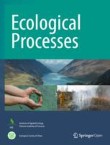View Item
- xmlui.general.dspace_homeCentros Regionales y EEAsCentro Regional Patagonia NorteEEA BarilocheArtículos científicosxmlui.ArtifactBrowser.ItemViewer.trail
- DSpace Home
- Centros Regionales y EEAs
- Centro Regional Patagonia Norte
- EEA Bariloche
- Artículos científicos
- View Item
Forage ofering and seasonal intake comparisons to evaluate European rabbit threat in Nothofagus forests of southern Patagonia
Abstract
Background: The European rabbit (Oryctolagus cuniculus L. 1758) was introduced into diferent regions of the world, generating signifcant trade-ofs that critically impacted native vegetation. Here, we evaluate the rabbit’s forage intakes in three vegetation types (forests, shrublands, and grasslands) along the four seasons in a temperate forest landscape in Southern Patagonia and discuss the potential threats over native vegetation. We formulated the
[ver mas...]
Background: The European rabbit (Oryctolagus cuniculus L. 1758) was introduced into diferent regions of the world, generating signifcant trade-ofs that critically impacted native vegetation. Here, we evaluate the rabbit’s forage intakes in three vegetation types (forests, shrublands, and grasslands) along the four seasons in a temperate forest landscape in Southern Patagonia and discuss the potential threats over native vegetation. We formulated the following questions: (i) what is the forage ofer at each vegetation type? (ii) what is the rabbit’s forage intake and how it varied across the seasons along the year? and (iii) which vegetation types and plant life forms were more used according to the rabbit’s forage intakes?
Methods: We censused understory vegetation to characterize the forage ofer at each vegetation type and determined seasonal dietary intakes using microhistological analysis of pellets. The plant species identifed in the feld were grouped according to life form classes (tree regeneration, shrubs, forbs, graminoids, orchids, ferns, bryophytes, and hemiparasites). Data were analysed through uni- and multivariate analyses, determining relationships between forage ofer and the rabbit’s forage intakes.
Results: Forage intakes revealed changes in plant life form consumption across vegetation types, where intake pressure was considerably diferent for tree regeneration (p=0.001), graminoids (p=0.001), and hemiparasites (p=0.001).
Besides, signifcant changes in consumption among seasons were detected for shrubs (p=0.001), ferns (p=0.030), and hemiparasites (p=0.002). Although many species play an important role in the rabbit’s forage intake networks (e.g., Chiliotrichum difusum, Holcus lanatus), the strongest intake linkages were found in exotic grasses (e.g., Poa pratensis and Festuca sp.), native hemiparasites (e.g., Misodendrum sp.), native shrubs (e.g., Empetrum rubrum), and native trees (e.g., Nothofagus sp.). The summer and autumn seasons presented higher intake compared to the winter and spring seasons. Furthermore, hemiparasites intake (e.g., Misodendrum sp.) suggests that rabbits utilize diferent forage sources depending on the vegetation types.
[Cerrar]

Author
Huertas Herrera, Alejandro;
Toro Manriquez, Monica;
Borrelli, Laura Beatriz;
Lencinas, María Vanessa;
Martinez Pastur, Guillermo José;
Fuente
Ecological Processes 11 : Art. 45 (Julio 2022)
Date
2022-07-05
Editorial
Springer Nature
ISSN
2192-1709
Formato
pdf
Tipo de documento
artículo
Palabras Claves
Derechos de acceso
Abierto
 Excepto donde se diga explicitamente, este item se publica bajo la siguiente descripción: Creative Commons Attribution-NonCommercial-ShareAlike 2.5 Unported (CC BY-NC-SA 2.5)
Excepto donde se diga explicitamente, este item se publica bajo la siguiente descripción: Creative Commons Attribution-NonCommercial-ShareAlike 2.5 Unported (CC BY-NC-SA 2.5)


